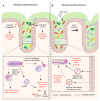Regulatory RNAs: A Universal Language for Inter-Domain Communication
- PMID: 33255483
- PMCID: PMC7727864
- DOI: 10.3390/ijms21238919
Regulatory RNAs: A Universal Language for Inter-Domain Communication
Abstract
In eukaryotes, microRNAs (miRNAs) have roles in development, homeostasis, disease and the immune response. Recent work has shown that plant and mammalian miRNAs also mediate cross-kingdom and cross-domain communications. However, these studies remain controversial and are lacking critical mechanistic explanations. Bacteria do not produce miRNAs themselves, and therefore it is unclear how these eukaryotic RNA molecules could function in the bacterial recipient. In this review, we compare and contrast the biogenesis and functions of regulatory RNAs in eukaryotes and bacteria. As a result, we discovered several conserved features and homologous components in these distinct pathways. These findings enabled us to propose novel mechanisms to explain how eukaryotic miRNAs could function in bacteria. Further understanding in this area is necessary to validate the findings of existing studies and could facilitate the use of miRNAs as novel tools for the directed remodelling of the human microbiota.
Keywords: RNA; communication; extracellular vesicles; miRNA; microbiota.
Conflict of interest statement
The authors declare no conflict of interest.
Figures


Similar articles
-
Extracellular Vesicles and Host-Pathogen Interactions: A Review of Inter-Kingdom Signaling by Small Noncoding RNA.Genes (Basel). 2021 Jun 30;12(7):1010. doi: 10.3390/genes12071010. Genes (Basel). 2021. PMID: 34208860 Free PMC article. Review.
-
Tiny RNAs and their voyage via extracellular vesicles: Secretion of bacterial small RNA and eukaryotic microRNA.Exp Biol Med (Maywood). 2017 Sep;242(15):1475-1481. doi: 10.1177/1535370217723166. Epub 2017 Jul 25. Exp Biol Med (Maywood). 2017. PMID: 28741379 Free PMC article. Review.
-
How Our Other Genome Controls Our Epi-Genome.Trends Microbiol. 2016 Oct;24(10):777-787. doi: 10.1016/j.tim.2016.05.005. Epub 2016 Jun 8. Trends Microbiol. 2016. PMID: 27289569 Review.
-
Nuclear microRNAs and their unconventional role in regulating non-coding RNAs.Protein Cell. 2013 May;4(5):325-30. doi: 10.1007/s13238-013-3001-5. Epub 2013 Apr 13. Protein Cell. 2013. PMID: 23584808 Free PMC article. Review.
-
Additional stories of microRNAs.Exp Biol Med (Maywood). 2014 Oct;239(10):1275-9. doi: 10.1177/1535370214544269. Epub 2014 Aug 4. Exp Biol Med (Maywood). 2014. PMID: 25092828 Review.
Cited by
-
Immunoregulatory molecules secreted by Trichuris muris.Parasitology. 2021 Jun 2;148(14):1-7. doi: 10.1017/S0031182021000846. Online ahead of print. Parasitology. 2021. PMID: 34075864 Free PMC article.
-
Adaptations of Bacterial Extracellular Vesicles in Response to Antibiotic Pressure.Int J Mol Sci. 2025 May 23;26(11):5025. doi: 10.3390/ijms26115025. Int J Mol Sci. 2025. PMID: 40507835 Free PMC article. Review.
-
Effects of gut microbiota-derived extracellular vesicles on obesity and diabetes and their potential modulation through diet.J Physiol Biochem. 2022 May;78(2):485-499. doi: 10.1007/s13105-021-00837-6. Epub 2021 Sep 2. J Physiol Biochem. 2022. PMID: 34472032 Free PMC article. Review.
-
MicroRNAs and extracellular vesicles in the gut: new host modulators of the microbiome?Microlife. 2021 Aug 10;2:uqab010. doi: 10.1093/femsml/uqab010. eCollection 2021. Microlife. 2021. PMID: 37223256 Free PMC article.
-
Characteristics of Transfer RNA-Derived Fragments Expressed during Human Renal Cell Development: The Role of Dicer in tRF Biogenesis.Int J Mol Sci. 2022 Mar 26;23(7):3644. doi: 10.3390/ijms23073644. Int J Mol Sci. 2022. PMID: 35409004 Free PMC article.
References
Publication types
MeSH terms
Substances
Grants and funding
LinkOut - more resources
Full Text Sources
Research Materials

